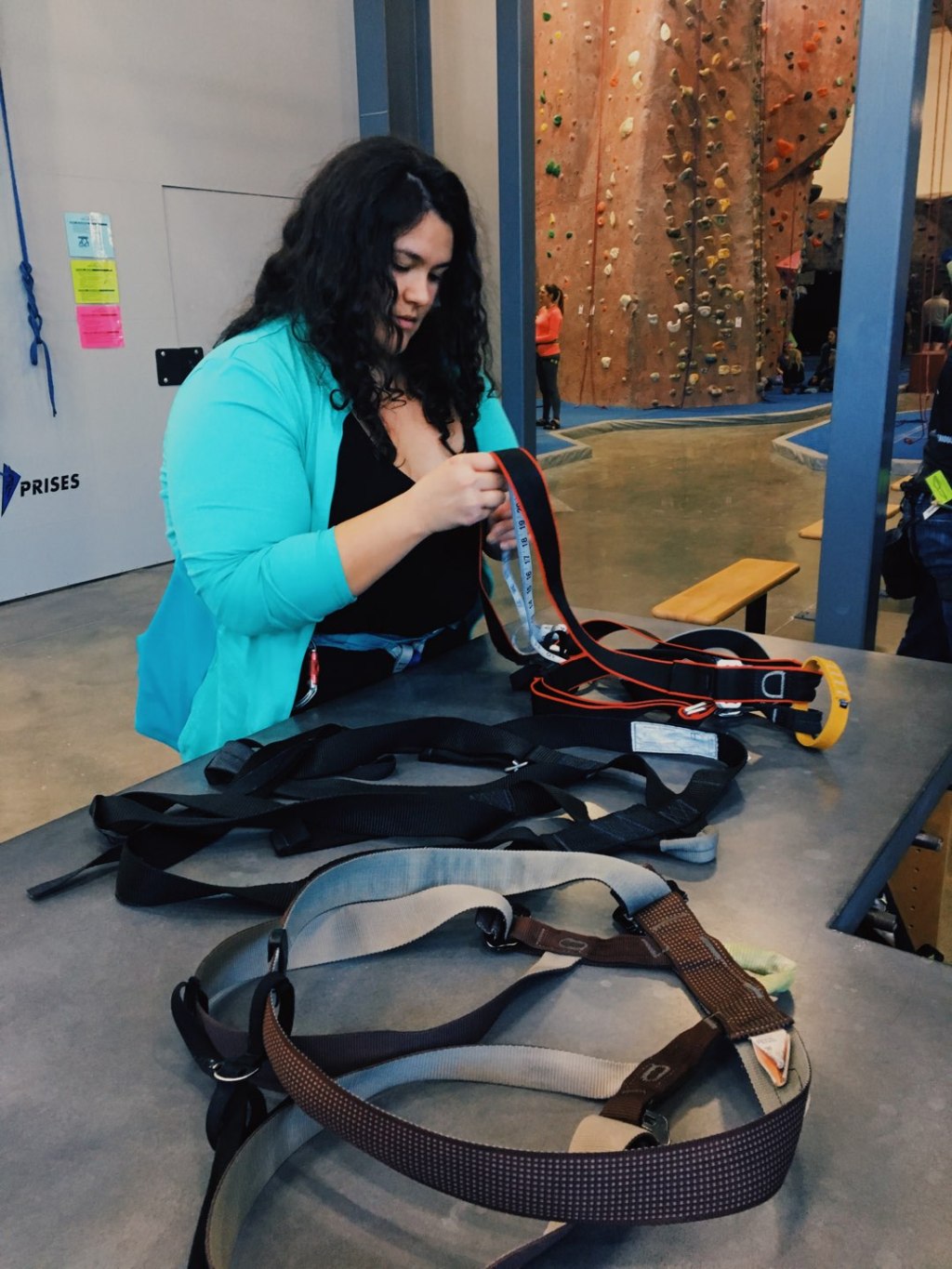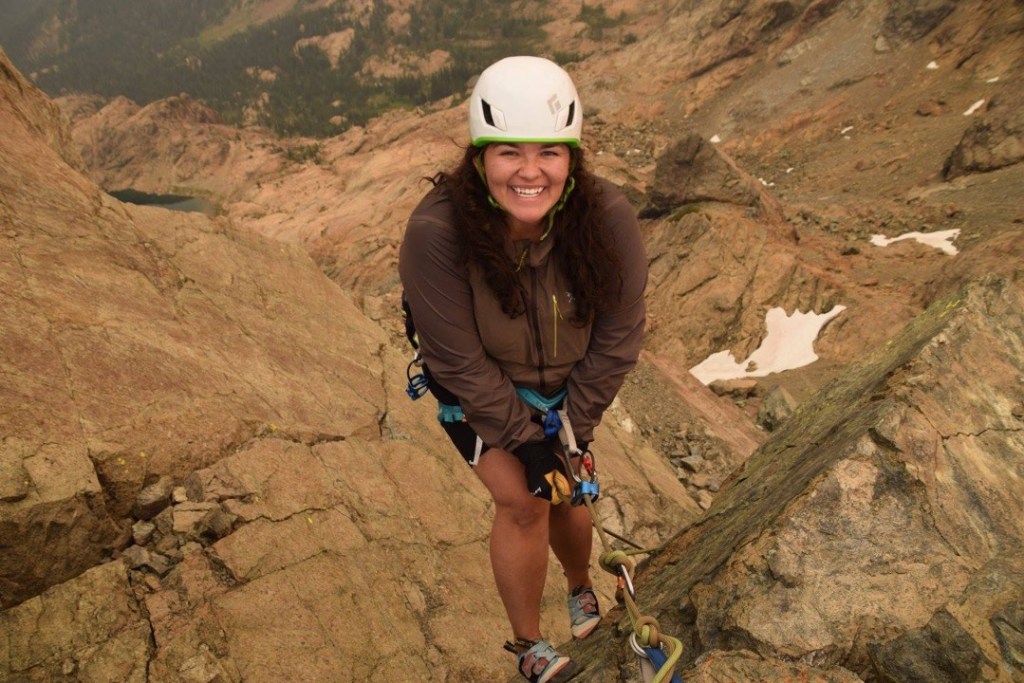Sam Ortiz grew up near Kentucky’s Red River Gorge, a canyon system renowned for sandstone cliffs that people travel from around the world to climb. Ortiz always loved scaling trees or scrambling up rocks along the trail as she hiked, and she had friends who were climbers, but hesitated to try it herself.
“I always wanted to, but I never once saw another person who was plus-size and very few people of color,” Ortiz says.
While she didn’t feel comfortable joining a group outside, eventually autobelays at a YMCA allowed her to gain confidence on her own time, and getting involved with The Mountaineers—a Pacific Northwest community that hosts courses and outings—helped her build skills. But even now, as an avid climber in Tacoma, Washington, Ortiz is one of many who have struggled to find gear that fits and to feel represented in the climbing world because of their size. Here’s how Ortiz and others are working to create a more inclusive climbing community.
The gear gap
The majority of harnesses for women top out at a size Large or X-Large—although a 2016 study shows the average American woman is a size 16, which, depending on the brand, is usually in that Large or X-Large category. Some climbing harness styles are designed specifically for women and tend to rise higher at the hip, fit smaller at the waist and larger at the thighs than men’s. There’s less recent data about the average male waistline, but 2012 data from the Centers for Disease Control and Prevention says it’s somewhere around 40 inches. Men’s harnesses sometimes reach XX-Large, topping out around 42-45 inches.
Using waist measurements can also be deceptive, Ortiz explains. A harness may have a maximum 40-inch waist, but if it doesn’t unclip at the waist—as many harnesses don’t—it may not be possible to pull it over a person’s butt or hips.
I reached out to several manufacturers, and of those who responded, none were working on expanding their sizes. In brands where harnesses do get larger, they’re typically for adventure parks or ziplines.
REI is aware of the lack of selection and is advocating for more sizes. “We’re pushing ourselves and pushing our vendors to be as inclusive as possible,” says Pam Robinson, the assistant category merchant in climbing at REI. “Our goal at the end of the day is to get people climbing and to give people the ability to do it.”
Some climbers choose to skip the harness altogether and boulder instead, says Bennett Rahn, a climber in Seattle. “Bouldering is great because it’s not gear-focused,” she says. “You just need shoes and you can rent shoes.”
Climbing technique
“I have been fat my whole life,” Rahn says. Through middle school and high school, she believed that meant she would never be athletic. Eventually, she found her way to hiking and then to climbing, a sport she loves.
Some climbers like Rahn and Ortiz say the amount of arm strength needed for more dynamic movements or to grip challenging handholds can be a deal breaker. Instead, the climbers I spoke with emphasized learning good foot technique and focusing on powering moves with their legs.
Smaller climbers don’t always understand that, Rahn explains. “I want you to tell me, ‘There’s a foot over there, can you get your right foot up?’ But not, ‘Have you tried pulling harder on that one crimp?’”
For some people, having a bigger frame helps them excel at techniques like delicate footwork. “I feel sorry for people who are really strong in their upper body because they don’t get to try that stuff,” Rahn says. “They only ever rely on pulling up.”
Keeping your weight close to the wall can also take on a different meaning. “You can’t be as close to the wall if you have a stomach, as opposed to when you’re flat stomached,” Ortiz says.
Working for more representation
The climbers I spoke with emphasized again and again that, on the whole, the climbing community is incredibly supportive. “Even though I’m a heavier climber, I’ve never had anyone say anything bad to my face—actually the exact opposite,” says Jeremy Arntz, a boulderer who is training to climb V5 by his 45th birthday.
But feeling supported within the community is not the same as seeing yourself or people you identify with in climbing media, something a number of climbers are working to see more of.
“I’ve been climbing for seven years and I’m a size 14,” says Alyx Levine. “Obviously the people who are in the media are people who are on the cutting edge of the sport, but it is really important to have that representation and to have it be more normalized that there are people who don’t look like that and climb really hard.” After years of climbing in Yosemite, Levine started Self Love Climbing in 2017, an Instagram dedicated to showing the diversity of “shapes, genders, sizes and colors” in the climbing world.
If you’re looking to start climbing yourself, here are a few tips:
The first move is simply showing up.
In addition to being plus-size, Kareemah Batts lost one of her legs to a rare form of cancer. But within a year of her remission, she started climbing. This led her to become the first female paraclimber in a USA Climbing competition, and to the launch of Adaptive Climbing Group, a climbing community for people with disabilities.
“There’s no proof that people like you exist there,” she says. That’s not just true in the media—gyms often lack representation when it comes to race, size and adaptive climbers. Even now, Batts will sometimes be at industry events talking about the work she’s doing and have people ask to meet the founder. Spoiler: That’s her. But she loves how climbing feels, and she now finds joy walking into a room where no one expects her to be.

Sam Ortiz inspects climbing harnesses at Edgeworks Climbing in Tacoma, Wash. Photo credit: Hannah Tennent.
Talk to your gym about rental gear and weight limitations.
The size of harnesses can be a significant hurdle for a larger person looking to climb. Gyms should be aware of the sizes they carry. If not, you can also ask for the brand and size and search specs on your own.
Climbing gyms should also be aware of the strength of their ropes, which must adhere to safety standards established by the Union Internationale des Associations d’Alpinisme.
Ghee-hee Yang, the safety department lead at Stone Gardens Bellevue in Washington, says the ropes at her gym can hold up to 1,956 pounds of force, and all of their holds use Class 12.9 steel bolts, which are basically as strong as they come. “Overall, we do not have any size or weight limitations,” Yang says.
You’ll want to confirm the weight limit of your gym’s autobelays. For example, Stone Gardens Bellevue’s autobelays can lower climbers up to 330 pounds. TrueBlue, which claims to be the most popular autobelay system, has a 330-pound limit. And Perfect Descent, the official autobelay of the International Federation of Sport Climbing has a 310-pound limit.
Learn how to belay.
Knowing how to belay is a great way to meet people and offers you a chance to take breaks while figuring out a route. Search for classes on how to belay in your local area or rock gym. If there’s a significant weight difference between you and your belay partner, your gym may have anchor points or weighted bags to help offset the difference.
Consider a technique class.
Classes range from beginner technique for bouldering and rock wall climbing to learning how to lead belay and understand more advanced movement.
“Taking classes was the big thing that pushed me from a person who was just trying something out to training,” Dowsett says. “I was taking very deliberate, slow and quiet moves, and I was getting to the top with more energy than I had before. I didn’t have to just get stronger, I had to be a smarter climber.”

Sam Ortiz begins a rappel on Ingalls Peak near Leavenworth, Wash. Photo Credit: Daniel Hernandez.
Don’t worry too much about grades right away.
“You don’t have to be a 5.11 climber in order for it to be your sport and to have fun,” Ortiz says.
Rahn agrees. “I really like rock climbing to be rock climbing, not to get a grade,” she says. “But there’s so much pressure to do that, and when you’re me and you’re a different shape than everyone, it’s really hard.”
And most importantly: Climbing is a great time. Nearly everyone echoed a famous Alex Lowe quote: “The best climber is the one having the most fun.”
Look for community.
One of the best parts about climbing is the people, Arntz says. Check for local Facebook climbing communities (try Your City + Rock Climbing), Meetup groups or organized events at your climbing gym or outdoor retailer. It doesn’t matter exactly what grades the people in the group climb. “Everybody can try what’s hardest for them and you just take turns,” explains Shannyn Dowsett, who created a plus-size climbing guide on her website Adventure(ish). “It’s this great equalizing activity where I can go with people at incredibly broad skill ranges and everybody still has a lot of fun and everybody still does what’s tricky for them.”
Or you can create your own group. Recently, Ortiz asked her local rock climbing gym, Edgeworks Climbing, to increase their rental plus-size harnesses from three to 10. As soon as the harnesses arrived, she launched a plus-size rock climbing Meetup. Ten women showed up from all around Washington state. She also recently launched a community Instagram account, @biggirlsclimbtoo.
“What I keep coming back to is that I am one of the only plus-size climbers that I know or can find,” she says. “I really wanted to share this with people.”


